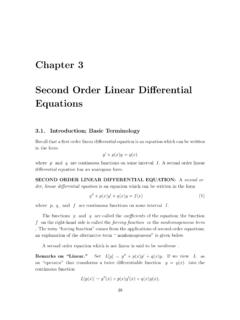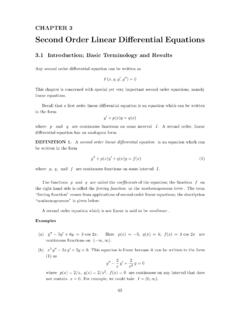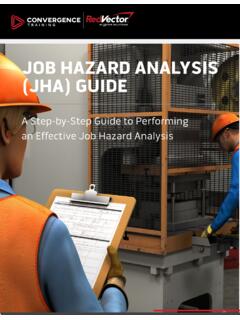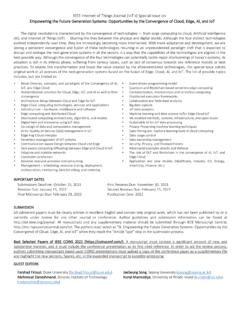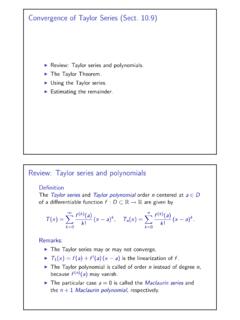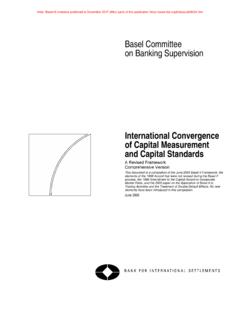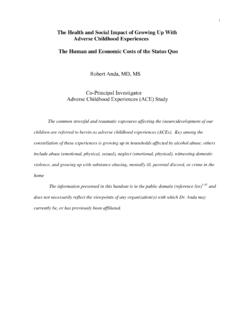Transcription of 2 Sequences: Convergence and Divergence
1 2 Sequences: Convergence and DivergenceIn , we consider (infinite) sequences, limits of sequences, andbounded and monotonic sequences of real numbers. In addition to certainbasic properties of convergent sequences, we also study divergent sequencesand in particular, sequences that tend to positive or negative infinity. Wepresent a number of methods to discuss convergent sequences together withtechniques for calculating their limits. Also, we prove thebounded monotoneconvergence theorem(BMCT), which asserts that every bounded monotonesequence is convergent. In , we define the limit superior and thelimit inferior.
2 We continue the discussion with Cauchy sequences and give ex-amples of sequences of rational numbers converging to irrational numbers. Asapplications, a number of examples and exercises are Sequences and Their LimitsAn infinite(real) sequence(more briefly, a sequence) is a nonterminatingcollection of (real) numbers consisting of a first number, a second number,a third number, and so on:a1,a2,a3,..Specifically, ifnis a positive integer, thenanis called thenth term of thesequence, and the sequence is denoted by{a1,a2,..,an,..}or, more simply,{an}.For example, the expression{2n}denotes the sequence 2,4,6.
3 Thus,asequence of real numbers is a special kind of function, one whose domain isthe set of all positive integers or possibly a set of the form{n:n k}forsome fixedk Z, and the range is a subset ofR. Let us now make this {an}is a real-valued functionfdefined onaset{k,k+1,k+2,..}. The functional valuesS. Ponnusamy,Foundations of Mathematical Analysis,DOI , Springer Science+Business Media, LLC 201223242 Sequences: Convergence and Divergencef(k),f(k+1),f(k+2),..are called thetermsof the sequence. It is customary to writef(n)=anforn k, so that we can denote the sequence by listing its terms in order; thuswe write a sequence as{an}n kor{an+k 1} n=1or{an} n=kor{ak,ak+1.}
4 }.The numberanis called thegeneral termof the sequence{an}(nth term,especially fork=1).Theset{an:n k}is called therange of the sequence{an}n k. Sequences most often begin withn=0orn=1,inwhichcasethe sequence is a function whose domain is the set of nonnegative integers(respectively positive integers). Simple examples of sequences are the se-quences of positive integers, , the sequence{an}for whichan=nforn 1,{1/n},{( 1)n},{( 1)n+1/n}, and the constant sequences for whichan=cfor sequenceis given bya0,a1=1,a2=2,an=an 1+an 2forn terms of this Fibonacci sequence are calledFibonacci numbers,andthefirst few terms are1,1,2,3,5,8,13, Limits of Sequences of Real NumbersA fundamental question about a sequence{an}concerns the behavior of itsnth termanasngets larger and larger.
5 For example, consider the sequencewhose general term isan=n+1n=1+ appears that the terms of this sequence are getting closer and closer to thenumber 1. In general, if the terms of a sequence can be made as close as weplease to a numberafornsufficiently large, then we say that the sequenceconverges is a precise definition that describes the behavior of (Limit of a sequence).Let{an}be a sequence of real num-bers. We say that the sequence{an}converges to the real numbera,ortendstoa, and we writea= limn anor simplya= liman,if for every >0, there is an integerNsuch that|an a|< whenevern Sequences and Their Limits25In this case, we call the numberaa limit of the sequence{an}.
6 We say thatthe sequence{an}converges (or is convergent or has limit) if it converges tosome numbera. A sequence diverges (or is divergent) if it does not convergeto any instance, in our example above we would expectlimn n+1n= notions of Convergence and limit of a sequence play a fundamental rolein R, other notations for the Convergence of{an}toaarelimn (an a)=0 andan aasn .The notationa= limanmeans thateventuallythe terms of the sequence{an}can be made as close toaas may be desired by takingnsufficiently also that|an a|< forn N an (a , a+ )forn is, a sequence{an}converges toaif and only if every neighborhood ofacontains all but a finite number of terms of the sequence.
7 SinceNdepends on , sometimes it is important to emphasize this and writeN( ) instead also that the definition requires someN, but not necessarily the smallestNthat works. In fact, if Convergence works for someNthen anyN1> motivate the definition, we again consideran=(n+1) >0,we notice that n+1n 1 =1n< whenevern>1 .Thus,Nshould be some natural number larger than 1/ . For example, if =1/99, then we may chooseNto be any positive integer bigger than 99,and we conclude that n+1n 1 < =199whenevern N= , if =2/999, then 1/ = , so that n+1n 1 < =2999whenevern N= ,Nclearly depends on.
8 The definition of limit makes it clear that changing a finite number of termsof a given sequence affects neither the Convergence nor the Divergence of thesequence. Also, we remark that the number provides a quantitative measureof closeness, and the numberNa quantitative measure of largeness. We now continue our discussion with a fundamental question:Is it possiblefor a sequence to converge to more than one limit?262 Sequences: Convergence and DivergenceTheorem (Uniqueness of limits).The limit of a convergent sequenceis thata= limananda = >0. Then there existtwo numbersN1andN2such that|an a|< forn N1and|an a |< forn particular, these two inequalities must hold forn N=max{N1,N2}.
9 Weconclude that|a a |=|a an (a an)| |an a|+|an a |<2 forn this inequality holds for every >0, and|a a |is independent of ,wemust have|a a |= 0, ,a=a .Also, as a direct consequence of the definition we obtain the following: Ifan a,thenan+k afor any fixed ,ifan aasn ,then for a given >0thereexistsanN Nsuch that|an a|< for alln ,|an+k a|< for alln+k N+k=N1or|am a|< form N1,which is same as saying thatam aasm .Definition {an}that converges to zero is called (i)The sequence{n}diverges because no matter whataand we choose, the inequalitya <n<a+ , ,|n a|< ,can hold only for finitely manyn.
10 Similarly, the sequence{2n}diverges.(ii)The sequence defined by{( 1)n}is{ 1,1, 1,1,..}, and this sequencediverges by oscillation because thenth term is always either 1 or 1. Thusancannot approach any one specific numberaasngrows large. Also, wenote that ifais any real number, we can always choose a positive number such that at least one of the inequalitiesa < 1<a+ ora <1<a+ is false. For example, the choice =|1 a|/2ifa =1,and =|1+a|/2ifa = 1, will do. Ifa=1or 1, choose to be any positive real numberless than 1. Thus the inequality|( 1)n a|< will be false for infinitelymanyn.







